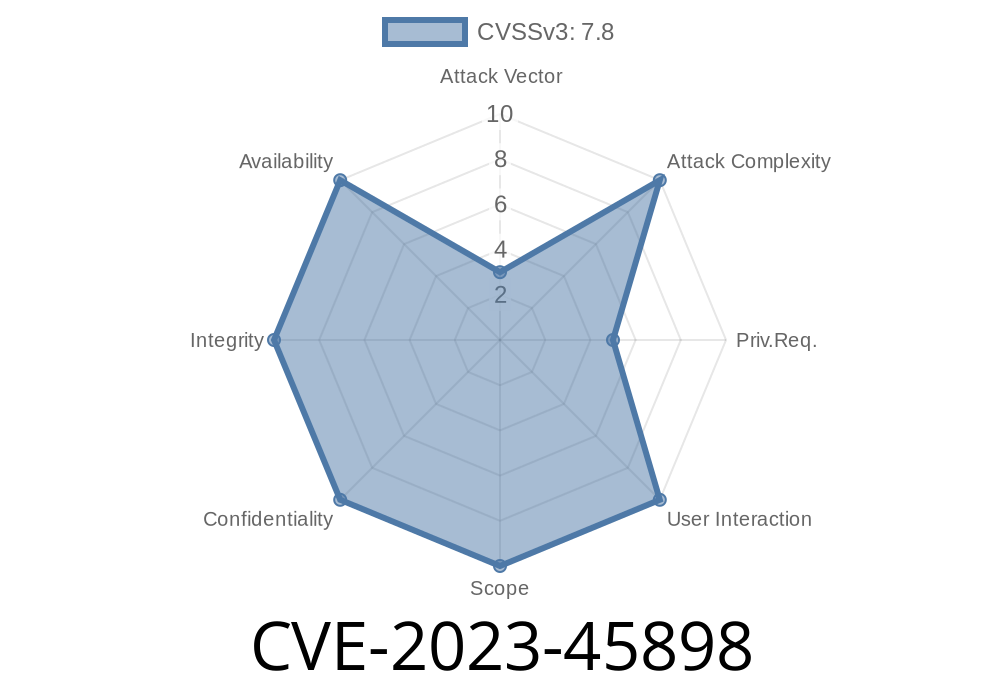Recently, a critical vulnerability was discovered in the Linux kernel before version 6.5.4. The vulnerability is related to the es1 use-after-free in the Ext4 filesystem's extents_status.c file and can potentially allow attackers to gain unauthorized access, execute arbitrary code, or even crash the system. In this post, we will dive deep into the vulnerability, its impact, and the method to exploit it. Furthermore, we will provide guidance on how to mitigate the issue and protect your systems.
Background on the Vulnerability
The issue, identified as CVE-2023-45898, stems from a use-after-free vulnerability in the Ext4 file system, specifically ext4_es_insert_extent(). The Linux kernel, even though having various memory management mechanisms, suffers from this vulnerability because of the mishandling of certain memory allocations. Consequently, an attacker can exploit this flaw to execute arbitrary code with kernel-level privileges.
The vulnerability affects the Linux kernel versions before 6.5.4 and is related to the es1 structure in the file fs/ext4/extents_status.c. Understanding the crux of this vulnerability requires delving into the es1 structure and function associated with its use-after-free vulnerability.
Code Snippet
The vulnerable code in the ext4_es_insert_extent function, located in the fs/ext4/extents_status.c file, can be seen in the following code snippet:
void ext4_es_insert_extent(struct inode *inode, ext4_lblk_t lblk,
ext4_lblk_t len, ext4_fsblk_t pblk,
unsigned int status)
{
struct ext4_es_tree *tree = &EXT4_I(inode)->i_es_tree;
struct rb_node **p = &tree->root.rb_node;
struct rb_node *parent = NULL;
struct extent_status *es;
[...]
es = kmem_cache_alloc(ext4_es_cachep, GFP_NOFS);
if (!es) {
es1->es_len = end - start + 1;
ext4_es_print_tree(tree);
es_stats(tree);
panic("No memory available for es\n");
}
es->rb_node = end + 1;
rb_link_node(&es->rb_node, parent, p);
rb_insert_color(&es->rb_node, &tree->root);
ext4_es_free_extent(inode, tree, es1);
}
Before we explore the bug, let's clarify the purpose of this function. ext4_es_insert_extent() is responsible for inserting memory allocated by kmem_cache_alloc() into the Red-Black tree. The problem occurs if the memory allocation fails, and the ext4_es_free_extent() function is called after the use of the es1 pointer, leading to a use-after-free scenario.
Exploit Details
When examining the vulnerability, the main exploit development challenge involves triggering the panic code path in ext4_es_insert_extent(). By forcing the memory allocation to fail and then attempting to use the es1 pointer after it has been freed in ext4_es_free_extent(), an attacker can trigger the use-after-free vulnerability and potentially execute arbitrary code.
Unfortunately, there are no publicly available exploits at the time of writing this post. However, it's worth considering the potential impact of this vulnerability if successfully exploited.
Mitigation Recommendations
As mentioned earlier, this vulnerability affects Linux kernel versions before 6.5.4. To mitigate the issue, the best course of action is to update the Linux kernel to version 6.5.4 or later. Linux kernel providers have already released patches to fix this vulnerability, so ensure that your systems are up to date.
If upgrading the kernel is not a viable option, monitor the Linux kernel mailing list for any reported exploits or updated information on the vulnerability. Administrators should also consider tightening security policies around memory allocations and the use of the Ext4 file system, restricting access to affected systems, and segmenting network access to prevent unauthorized users from attempting to exploit the vulnerability.
Original References
- Linux kernel git commit related to the fix
- CVE-2023-45898 vulnerability details in the National Vulnerability Database
Conclusion
CVE-2023-45898 highlights the importance of continuously updating and patching software to the latest releases. It is essential to keep your systems up to date, apply security best practices, and maintain constant vigilance to protect your infrastructure from ever-evolving threats.
Timeline
Published on: 10/16/2023 03:15:09 UTC
Last modified on: 11/07/2023 04:21:49 UTC
